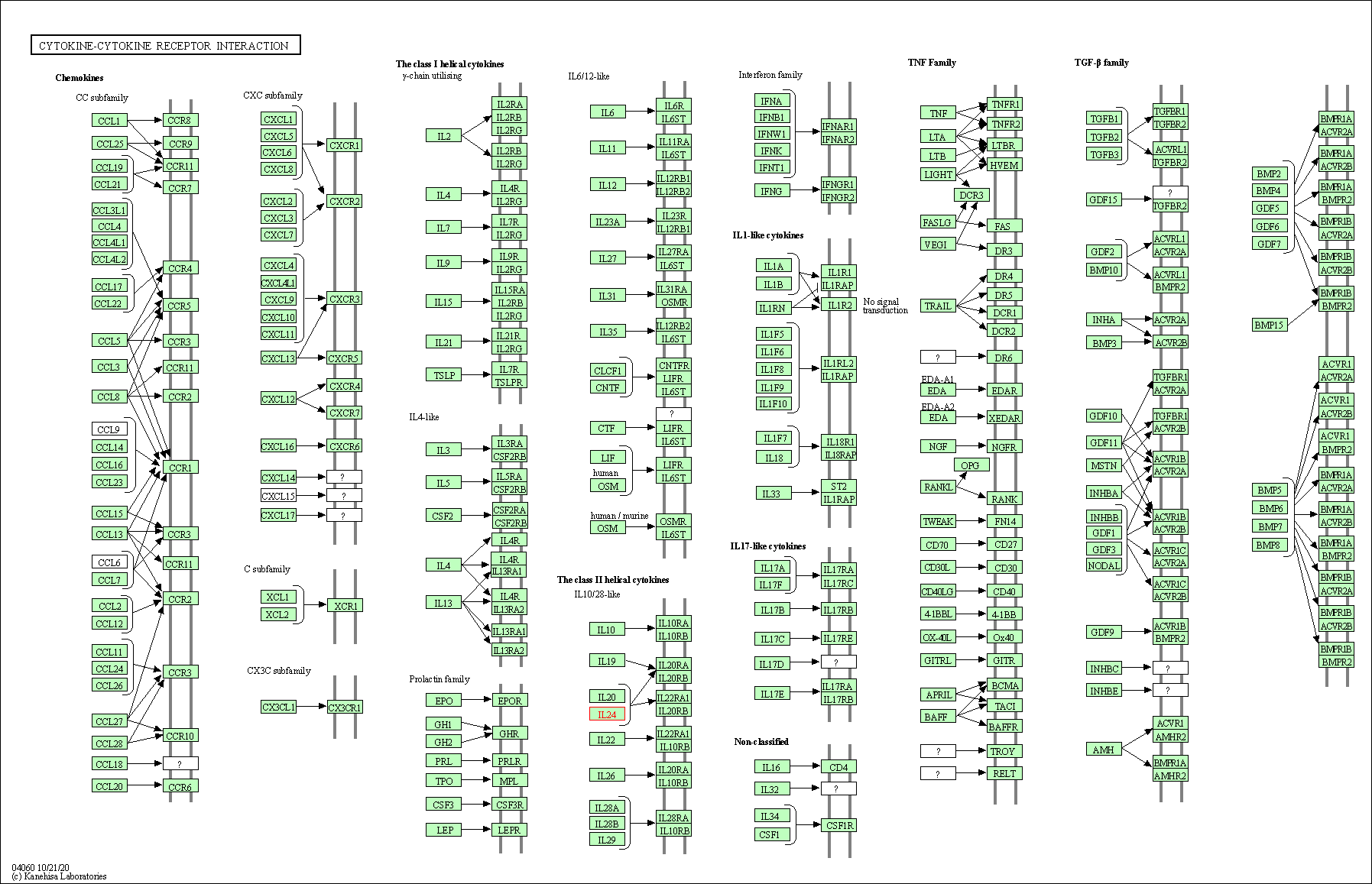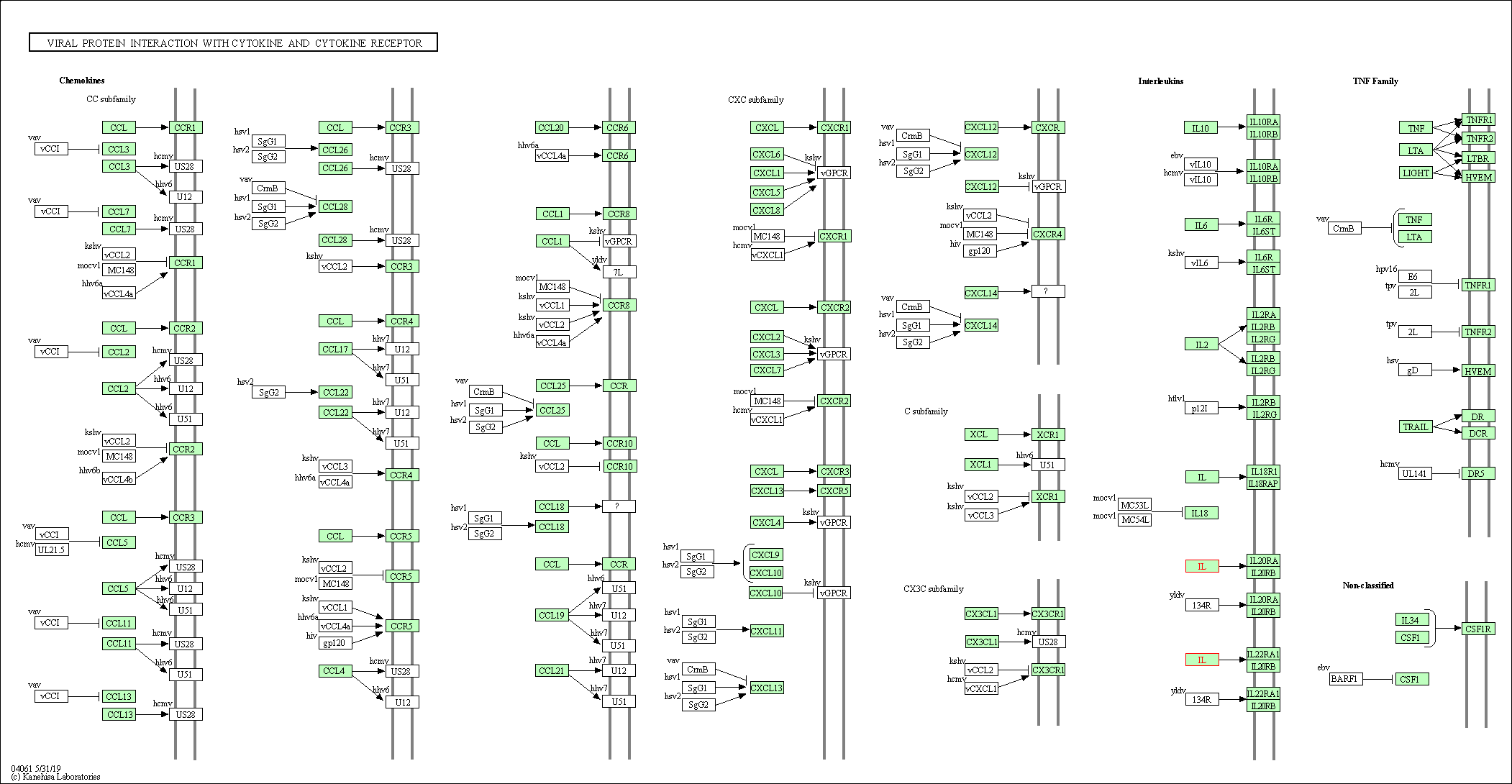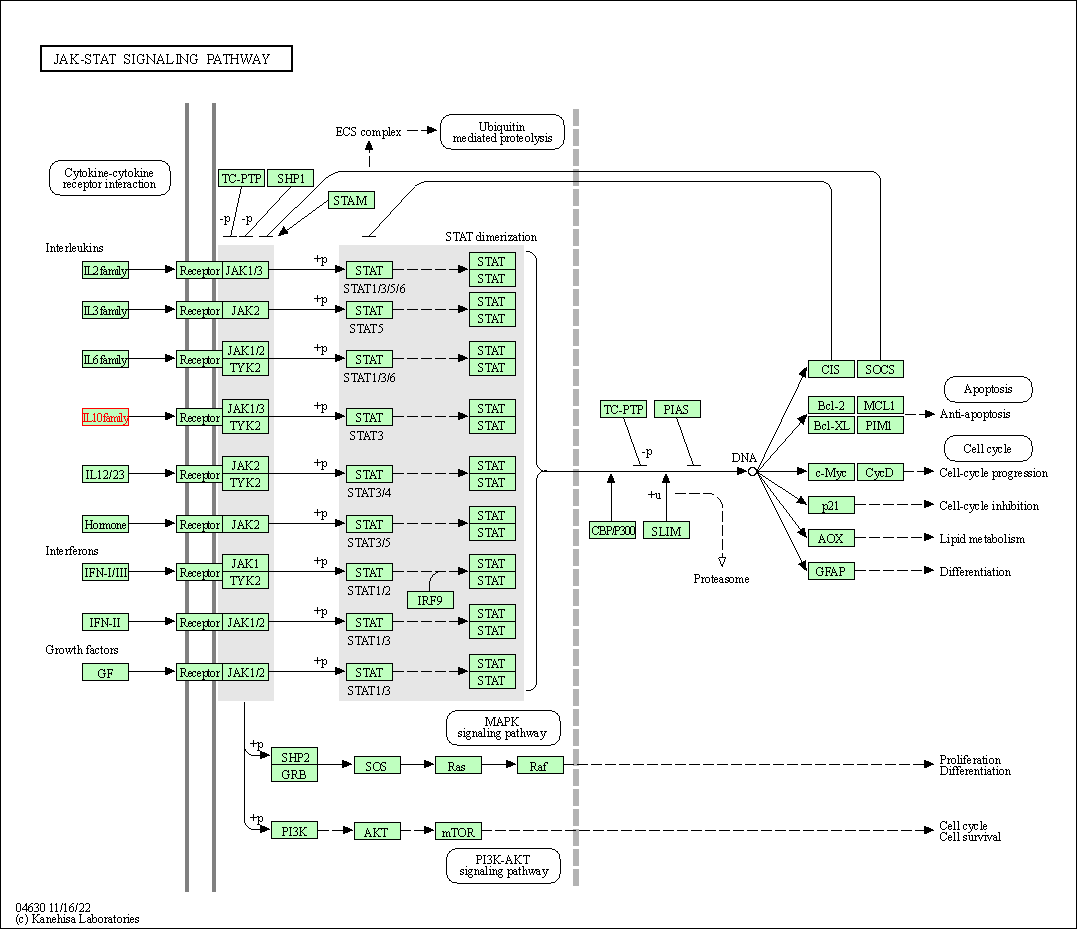Target Information
| Target General Information | Top | |||||
|---|---|---|---|---|---|---|
| Target ID |
T93450
(Former ID: TTDI02335)
|
|||||
| Target Name |
Interleukin-24 (IL24)
|
|||||
| Synonyms |
Suppression of tumorigenicity 16 protein; ST16; Melanoma differentiationassociated gene 7 protein; Melanoma differentiation-associated gene 7 protein; MDA7; MDA-7; Interleukin24; IL-24
Click to Show/Hide
|
|||||
| Gene Name |
IL24
|
|||||
| Target Type |
Clinical trial target
|
[1] | ||||
| Disease | [+] 1 Target-related Diseases | + | ||||
| 1 | Solid tumour/cancer [ICD-11: 2A00-2F9Z] | |||||
| Function |
Has antiproliferative properties on melanoma cells and may contribute to terminal cell differentiation.
Click to Show/Hide
|
|||||
| BioChemical Class |
Cytokine: interleukin
|
|||||
| UniProt ID | ||||||
| Sequence |
MNFQQRLQSLWTLARPFCPPLLATASQMQMVVLPCLGFTLLLWSQVSGAQGQEFHFGPCQ
VKGVVPQKLWEAFWAVKDTMQAQDNITSARLLQQEVLQNVSDAESCYLVHTLLEFYLKTV FKNYHNRTVEVRTLKSFSTLANNFVLIVSQLQPSQENEMFSIRDSAHRRFLLFRRAFKQL DVEAALTKALGEVDILLTWMQKFYKL Click to Show/Hide
|
|||||
| 3D Structure | Click to Show 3D Structure of This Target | AlphaFold | ||||
| Drugs and Modes of Action | Top | |||||
|---|---|---|---|---|---|---|
| Clinical Trial Drug(s) | [+] 1 Clinical Trial Drugs | + | ||||
| 1 | INGN-241 | Drug Info | Phase 2 | Solid tumour/cancer | [2] | |
| Mode of Action | [+] 1 Modes of Action | + | ||||
| Inhibitor | [+] 1 Inhibitor drugs | + | ||||
| 1 | INGN-241 | Drug Info | [1] | |||
| Cell-based Target Expression Variations | Top | |||||
|---|---|---|---|---|---|---|
| Cell-based Target Expression Variations | ||||||
| Different Human System Profiles of Target | Top |
|---|---|
|
Human Similarity Proteins
of target is determined by comparing the sequence similarity of all human proteins with the target based on BLAST. The similarity proteins for a target are defined as the proteins with E-value < 0.005 and outside the protein families of the target.
A target that has fewer human similarity proteins outside its family is commonly regarded to possess a greater capacity to avoid undesired interactions and thus increase the possibility of finding successful drugs
(Brief Bioinform, 21: 649-662, 2020).
Human Pathway Affiliation
of target is determined by the life-essential pathways provided on KEGG database. The target-affiliated pathways were defined based on the following two criteria (a) the pathways of the studied target should be life-essential for both healthy individuals and patients, and (b) the studied target should occupy an upstream position in the pathways and therefore had the ability to regulate biological function.
Targets involved in a fewer pathways have greater likelihood to be successfully developed, while those associated with more human pathways increase the chance of undesirable interferences with other human processes
(Pharmacol Rev, 58: 259-279, 2006).
Biological Network Descriptors
of target is determined based on a human protein-protein interactions (PPI) network consisting of 9,309 proteins and 52,713 PPIs, which were with a high confidence score of ≥ 0.95 collected from STRING database.
The network properties of targets based on protein-protein interactions (PPIs) have been widely adopted for the assessment of target’s druggability. Proteins with high node degree tend to have a high impact on network function through multiple interactions, while proteins with high betweenness centrality are regarded to be central for communication in interaction networks and regulate the flow of signaling information
(Front Pharmacol, 9, 1245, 2018;
Curr Opin Struct Biol. 44:134-142, 2017).
Human Similarity Proteins
Human Pathway Affiliation
Biological Network Descriptors
|
|
| Protein Name | Pfam ID | Percentage of Identity (%) | E value |
|---|---|---|---|
| Interleukin-24 (IL24) | 100.000 (206/206) | 2.12E-154 | |
| Interleukin-19 (IL19) | 29.927 (41/137) | 9.82E-16 | |
| Interleukin-20 (IL20) | 33.742 (55/163) | 1.31E-15 | |



| KEGG Pathway | Pathway ID | Affiliated Target | Pathway Map |
|---|---|---|---|
| Cytokine-cytokine receptor interaction | hsa04060 | Affiliated Target |

|
| Class: Environmental Information Processing => Signaling molecules and interaction | Pathway Hierarchy | ||
| Viral protein interaction with cytokine and cytokine receptor | hsa04061 | Affiliated Target |

|
| Class: Environmental Information Processing => Signaling molecules and interaction | Pathway Hierarchy | ||
| JAK-STAT signaling pathway | hsa04630 | Affiliated Target |

|
| Class: Environmental Information Processing => Signal transduction | Pathway Hierarchy | ||
| Degree | 3 | Degree centrality | 3.22E-04 | Betweenness centrality | 9.37E-05 |
|---|---|---|---|---|---|
| Closeness centrality | 1.79E-01 | Radiality | 1.30E+01 | Clustering coefficient | 6.67E-01 |
| Neighborhood connectivity | 6.00E+00 | Topological coefficient | 5.00E-01 | Eccentricity | 13 |
| Download | Click to Download the Full PPI Network of This Target | ||||
| Target Regulators | Top | |||||
|---|---|---|---|---|---|---|
| Target-regulating microRNAs | ||||||
| Target Affiliated Biological Pathways | Top | |||||
|---|---|---|---|---|---|---|
| KEGG Pathway | [+] 2 KEGG Pathways | + | ||||
| 1 | Cytokine-cytokine receptor interaction | |||||
| 2 | Jak-STAT signaling pathway | |||||
| NetPath Pathway | [+] 2 NetPath Pathways | + | ||||
| 1 | IL-7 Signaling Pathway | |||||
| 2 | IL2 Signaling Pathway | |||||
| PID Pathway | [+] 1 PID Pathways | + | ||||
| 1 | IL23-mediated signaling events | |||||
| WikiPathways | [+] 1 WikiPathways | + | ||||
| 1 | Senescence and Autophagy in Cancer | |||||
| References | Top | |||||
|---|---|---|---|---|---|---|
| REF 1 | Intratumoral injection of INGN 241, a nonreplicating adenovector expressing the melanoma-differentiation associated gene-7 (mda-7/IL24): biologic outcome in advanced cancer patients. Mol Ther. 2005 Jan;11(1):160-72. | |||||
| REF 2 | ClinicalTrials.gov (NCT00116363) Safety and Efficacy Study of INGN 241 Gene Therapy in Patients With In Transit Melanoma. U.S. National Institutes of Health. | |||||
If You Find Any Error in Data or Bug in Web Service, Please Kindly Report It to Dr. Zhou and Dr. Zhang.

